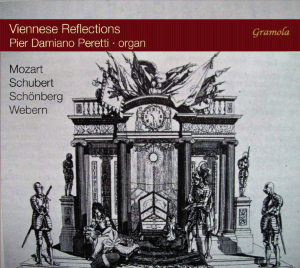
Viennese Reflections
Wolfgang Amadeus Mozart (1756-1791)
Fantasy in F minor K.608 (‘for a mechanical clockwork organ’) (1791)
Fantasy in F minor K594 (‘for a mechanical clockwork organ’) (1790)
Arnold Schoenberg (1874-1951)
Six Little Piano Pieces Op. 19 (1911) (arr. P. D. Peretti)
Franz Schubert (1797-1828)
Fugue in E minor Op. 152 (D 952) (1828)
Fantasy in F minor for four-handed piano Op. 103 (D 940) (1828) (arr. P. D. Peretti)
Adagio in G major D 178 (1815)
Anton Webern (1883-1945)
Variations for piano Op. 27 (1935-36) (arr. P. D. Peretti)
Pier Damiano Peretti (organ)
rec. 2021/22, Lenter organ, Lutherische Stadtkirche, Wien.
Gramola 99250 [75]
Pier Damiano Peretti’s new disc is unusual in that, strictly speaking, only one work included in his programme was intended for the pipe organ and that is Schubert’s Fugue in E minor Op.152 (D952), which can hardly be regarded as typical. The disc begins and ends with Mozart’s two most significant works for the instrument, but even here, all is not quite what it seems. These pieces were intended for a set of pipes within a clock. Mozart wrote to his wife about the commission and his reluctance to fulfil it, since ‘…the thing consists solely of a punch of little pipes, which sound shrill and too childish for my taste.’ The performer makes the point that, for all their seemingly lowly place in Mozart’s output, among his contemporaries and colleagues they became well known and shortly after his death, appeared in arrangements for both piano solo and duet. It seems arguable that they were influential in the genesis of Schubert’s Fantasia in F minor for piano duet, an impression greatly strengthened by hearing the two works in close juxtaposition.
The piano pieces by Schoenberg and Webern at first sight seem even more out of place in this company, but appear to gain from the wider tonal palette that the organ permits and curiously, reveal an affinity with later, mid-twentieth century compositions for organ. Peretti’s imaginative use of registration greatly helps to convince the sceptical listener that these pieces have their place within the performer’s design.
Schubert’s great F minor Fantasy for piano duet, curiously described here as for ‘four-handed Piano’, transfers to the organ surprisingly well. The inclusion of the E minor Fugue Op. 152 is enlightening, even though it bears all the signs of being simply a composition exercise. The contrapuntal final section of the Fantasy confirms the impression, initially created by listening to the Fugue, that academic counterpoint was not Schubert’s strongest suit.
Where Schubert departs from Mozart’s earlier examples of the keyboard Fantasy, is by including a quasi-Scherzo section, which Mozart does not. At first the performance of this portion may sound a little cautious, lacking the unbuttoned freedom that duettists can achieve by dividing the workload between them. However, having regard to the acoustic of the church and the fact that the instrument chosen is contemporary with much of the music, the speed discloses itself as being entirely fitting, with right amount of swagger, while maintaining the dignity of the instrument.
Altogether, this is a most enjoyable recital combining the well known and more obscure, but illuminating all the items by the way in which they are presented, disclosing hitherto unsuspected connections and affinities. The performances are wholly convincing and immaculately turned and the Lenter organ of the Lutheran State Church of Vienna is tonally perfect for all the varied demands made upon it. A superb recording.
Martyn Strachan
Help us financially by purchasing from





















